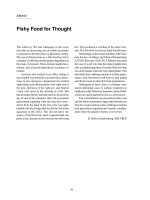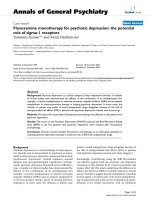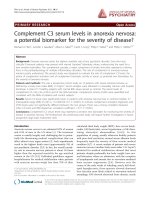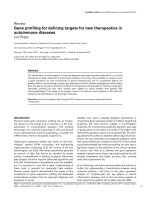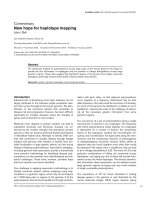Báo cáo y học: "issed opportunities for participation in prevention of mother to child transmission programmes: Simplicity of nevirapine does not necessarily lead to optimal uptake, a qualitative stud?" pdf
Bạn đang xem bản rút gọn của tài liệu. Xem và tải ngay bản đầy đủ của tài liệu tại đây (208.98 KB, 5 trang )
BioMed Central
Page 1 of 5
(page number not for citation purposes)
AIDS Research and Therapy
Open Access
Research
Missed opportunities for participation in prevention of mother to
child transmission programmes: Simplicity of nevirapine does not
necessarily lead to optimal uptake, a qualitative study
Lungiswa L Nkonki*
1
, Tanya M Doherty
1,2
, Zelee Hill
3
, Mickey Chopra
1,4
,
Nikki Schaay
4
and Carl Kendall
3
Address:
1
Health Systems Research Unit, Medical Research Council, Cape Town, South Africa,
2
Research Programme, Health Systems Trust, Cape
Town, South Africa,
3
Tulane School of Public Health and Tropical Medicine, Tulane University, New Orleans, USA and
4
School of Public Health,
University of the Western Cape, Cape Town, South Africa
Email: Lungiswa L Nkonki* - ; Tanya M Doherty - ; Zelee Hill - ;
Mickey Chopra - ; Nikki Schaay - ; Carl Kendall -
* Corresponding author
Abstract
Background: The objective of this study was to examine missed opportunities for participation
in a prevention of mother-to-child transmission (PMTCT) programme in three sites in South Africa.
A rapid anthropological assessment was used to collect in-depth data from 58 HIV-positive women
who were enrolled in a larger cohort study to assess mother-to-child HIV transmission. Semi-
structured interviews were conducted with the women in order to gain an understanding of their
experiences of antenatal care and to identify missed opportunities for participation in PMTCT.
Results: 15 women actually missed their nevirapine not because of stigma and ignorance but
because of health systems failures. Six were not tested for HIV during antenatal care. Two were
tested but did not receive their results. Seven were tested and received their results, but did not
receive nevirapine. Health Systems failure for these programme leakages ranged from non-
availability of counselors, supplies such as HIV test kits, consent forms, health staff giving the
women incorrect instructions about when to take the tablet and health staff not supplying the
women with the tablet to take.
Conclusion: HIV testing enables access to PMTCT interventions and should therefore be
strengthened. The single dose nevirapine regimen is simple to implement but the all or nothing
nature of the regimen may result in many missed opportunities. A short course dual or triple drug
regimen could increase the effectiveness of PMTCT programmes.
Introduction
HIV/AIDS is the leading cause death among young chil-
dren and is estimated to account for 40% of the deaths in
2000 in South Africa [1]. The HIV prevalence amongst
antenatal clients across the country is 29%[2] and projec-
tions indicate that without effective prevention of mother-
to-child transmission (PMTCT), the child mortality rate is
likely to have continued to rise in subsequent years [3].
Published: 22 November 2007
AIDS Research and Therapy 2007, 4:27 doi:10.1186/1742-6405-4-27
Received: 26 June 2007
Accepted: 22 November 2007
This article is available from: />© 2007 Nkonki et al; licensee BioMed Central Ltd.
This is an Open Access article distributed under the terms of the Creative Commons Attribution License ( />),
which permits unrestricted use, distribution, and reproduction in any medium, provided the original work is properly cited.
AIDS Research and Therapy 2007, 4:27 />Page 2 of 5
(page number not for citation purposes)
The PMTCT package comprises of a series of interventions
namely VCT, ARV prophylaxis (in South Africa, short
course nevirapine) [4], infant feeding counselling and
postnatal follow-up care. Each aspect of the programme is
important and a deficiency in any of the programme
aspects will impact negatively on overall effectiveness,
thereby compromising the ultimate goal of PMTCT, infant
HIV-free survival [5].
A single maternal dose of nevirapine (NVP) between two
and twenty-four hours before delivery and an infant dose
within 72 hours post-delivery reduces mother-to-child
HIV transmission by up to 50% [6]. The simplicity and
effectiveness of this regime has led to its widespread adop-
tion in PMTCT programmes in developing countries.
However, operational studies have found that less than
half of mothers testing HIV positive routinely receive even
this simple regimen [7-9]. This poor performance has
been used to delay the introduction of more complex but
effective prophylactic interventions such as short course
AZT during pregnancy boosted by single dose NVP during
delivery.
In South Africa the PMTCT programme has reached
national coverage. Over 95% of pregnant women attend
antenatal care (ANC) with an average of more than 3 visits
per pregnancy[10] and uptake of HIV testing for pregnant
women has reached 70% in areas where the programme
has been prioritized [11]. Despite the high ANC and HIV
testing uptake, data from a 2003 programmatic evaluation
showed that up to 50% of women who are recruited into
the PMTCT programme do not actually receive nevirapine
according to the national protocol [12]. National routine
data indicates a 51.7% national NVP coverage, with large
variations between and within districts. For instance three
districts within a poorly resourced province have an over-
all coverage of 70% whereas there is one with only
16.5%[11]. The aim of this study was to investigate why,
in the context of apparently functioning and accessible
health services in terms of ANC coverage, such large num-
bers of women are not getting a relatively simple HIV
intervention.
Methods
A rapid anthropological assessment was used to collect in-
depth data from 58 HIV positive women who were
enrolled in a larger cohort study to assess mother to child
HIV transmission. The quantitative cohort study had a
final sample of 625. 123 Women were randomly selected
from the quantitative cohort using a random number
table. Randomly selected women were then interviewed
until we reached a point of data saturation. Data collec-
tion took place between April and June 2005. Semi-struc-
tured interviews were conducted with randomly selected
women from the larger cohort in order to gain an under-
standing of their experiences of antenatal care and to iden-
tify missed opportunities for participation in PMTCT.
Study sites
Three sites were purposively selected to reflect different
socio-economic profiles, rural-urban locations and HIV
prevalence rates. Site A is a peri-urban area with an ante-
natal prevalence of 15%[12], a well resourced health sys-
tem and a higher socio-economic profile than the other
sites. Site B, is a rural area in one of the poorest regions of
South Africa with a poorly resourced health system and an
antenatal HIV prevalence of 28%[12]. Site C, is a peri-
urban area with an antenatal prevalence of 41% [12] and
an moderately well resourced health system compared to
the other two sites.
Data collection and analysis
Selected women were approached and consented in their
community and either interviewed at home or, if privacy
was an issue, in the project office. Interviews lasted
between 45 minutes and 3 hours and were conducted in
local languages by six trained field researchers. The six
field researchers used a semi-structured guide, which con-
tained suggested questions for each research theme. Data
analysed for this paper included descriptions of testing,
counseling and diagnosis; details of support and care
received after diagnosis (including details of the PMTCT
programme); perceptions of quality of care and contex-
tual information about diagnosis, disclosure and living
conditions. Each field researcher conducted one interview
a day, during which they recorded brief field notes. Each
afternoon the field researcher worked with the study site
supervisors to convert their field notes to English fair-
notes. Fairnotes were then keyed into MS word by the
study transcriber.
Preliminary data analysis occurred concurrently with data
collection. We made use of the inductive generation of
coding categories. In this approach, investigators first
review all notes; identify important descriptive categories
and themes and code sections of text for the presence of
these themes. The investigators did this individually, then
met and discussed the results until they reached consen-
sus.
Ethical approval was obtained from the University of
Western Cape all participants signed informed consent for
interviews. The anonymity of participants was protected
during data collection and analysis by the use of partici-
pant codes.
Results
All the women had attended antenatal care during their
pregnancies with the exception of one. The mean age of
the mothers was 26.3 years. A quarter (15/58) of the HIV
AIDS Research and Therapy 2007, 4:27 />Page 3 of 5
(page number not for citation purposes)
positive women reported having missed their NVP dose.
Reasons for missing the dose fell into three main catego-
ries (Table 1).
1: No HIV test during ante-natal care
Six of the fifteen women who missed their NVP belonged
to this group. Five of the six women would have liked to
have been tested but were not tested due to health system
failures including non-availability of counselors, supplies
such as HIV test kits or consent forms: Only one respond-
ent made a conscious effort to avoid finding out her HIV
status due to fear of being HIV positive (Table 2).
2: Tested and did not receive results until after delivery
Two respondents belonged to this group, both of whom
attended ante-natal care on numerous occasions. In one
case health workers failed to notice that the respondent
had not received her test results and in the other case the
woman was tested the day before she gave birth and was
given her results the day after birth (Table 3).
3: Tested, received results but did not take NVP
Seven women tested and knew their results but did not
receive nevirapine at the correct time or at all. For three
women the reasons were related to their personal situa-
tion: losing the tablet, forgetting to take the tablet because
of an intense labor, and avoiding collecting the tablet
because they did not believe their test results: For four
women the reasons were directly related to health system
failures including health staff giving the women incorrect
instructions about when to take the tablet and health staff
not supplying the women with the tablet to take (Table 4).
Discussion
In this study there were a series of missed opportunities
that led to women not receiving nevirapine according to
the national PMTCT protocol[4]. A quarter (15) of the
women reported not taking nevirapine. Six of the women
did not get tested and were of unknown status prior to
delivery. Reasons for not testing were mainly health sys-
tems failures such as non-availability of counselors and
supplies. Two of the 15 women did not receive their HIV
test results until after delivery. In both instances the
women had attended antenatal care on numerous occa-
sions yet health workers failed to give them NVP in time.
Seven of the 15 women tested, received results but did not
take NVP not because of stigma, ignorance but because of
the immediate context of the birth process in addition to
health system failures.
Fear of knowing one's HIV status and disbelief of test
results have been described previously as important rea-
sons for drop out from PMTCT services [13,14] however,
in our sample this explained only a minority of missed
opportunities. Evidence from other programmes suggests
that such fears are likely to be reduced further as the pro-
gramme becomes more established[15]. Instead it was
health system constraints related to testing and the provi-
sion of results that were the key reasons for missed oppor-
tunities. A lack of counselors and testing equipment was
found to be prevalent across the country during early eval-
uations of the PMTCT pilot programme [12].
Of great importance is the functioning of the health sys-
tem. 40% of our respondents had not been tested due to
health systems failures. HIV testing serves as an entry
point to PMTCT. A weak health system allows for leakage
in essential steps such as HIV testing, which undermines
the intervention. Strengthening testing uptake and logis-
tics is urgently required. However, it is important to note
that these missed opportunities occurred within the con-
text of opt-in VCT. Routine offer (opt out) of HIV testing
within antenatal care (i.e. antenatal HIV testing is part of
Table 3: Tested and did not receive results until after delivery
Health Systems reasons:
'She says she comes close to stay at the hospital since it was her first
time to get a baby but the nurses took blood from her at the last
moment and not even having time to tell her good or bad things about
testing and the worst thing is that she was not given NVP yet she was
here for almost a month and she was treated like someone who was
not attending ANC who just came in on labour at the last moment.
Yet nurses are preaching that people should attend ANC so that they
don't miss opportunities to know about how to be the mother for the
first time and she feels it was very bad for her to realise that she was
supposed to get NVP. RG06WB'
Table 1: Reasons for missed opportunities per category
Overall Sample
size n = 58
Categories n = 15 Reasons for missed
opportunities
Category 1 (n = 6) No HIV test during ante-natal
care
Category 2 (n = 2) Tested and did not receive
results until after delivery
Category 3 (n = 7) Tested and did not receive
results until after delivery
Table 2: No HIV test during ante-natal care
Non-health systems reasons:
'She did not go to Hospital A for ANC because she knew that she will
have to test at ANC. She thought of the baby she is carrying and that
if at present moment she can be told for sure that she is positive she
will die for sure. PG06TM'
Health systems reasons:
"She was always told that a "VCT" nurse was not there on the days
she visited and she was also told that there are no injections to draw
blood. RG07VM"
'She was attending her ANC at <a local clinic> which she pays R10
return in a taxi to get to this clinic and it is a closer clinic to her. She
was not tested during her ANC because there were not forms to sign
before getting tested. RG05VM"
AIDS Research and Therapy 2007, 4:27 />Page 4 of 5
(page number not for citation purposes)
routine screening for infections, including hepatitis B,
syphilis and rubella) has been advocated. There is evi-
dence from various studies which demonstrates that an
opt-out approach to VCT identifies a greater proportion of
those infected [16-20] and provides greater opportunities
for HIV care and treatment.
However, the discussions on the VCT opt-out approach
assume that the quality of care in all settings is optimal.
Findings from developing countries do not support this
assumption. For instance a recent publication from South
Africa showed only 28.6% of women from a rural site had
a syphilis test performed [5]. Given these results it is
unclear how the VCT opt-out approach would address the
current missed opportunities occurring in the VCT opt in
approach.
The second reason for missed opportunities in this study
was health system constraints related to mothers not
receiving their results. The testing kit used in this context
is the rapid HIV test. It is therefore unclear why women
were not given their results and this issue requires further
exploration.
The last groups of women were those who knew their sta-
tus and also knew they had to take NVP but still did not
take it. For reasons related to tablet provision and instruc-
tion giving, in many cases the problem stemmed from
poor communication and a lack of a locus of responsibil-
ity. Improving communication could reduce these missed
opportunities. On the otherhand the locus of responsibil-
ity presents a challenge. According to the PMTCT protocol
women should get NVP during antenatal care to self
administer at the onset of labour. However, in this group
the responsibility of administering the NVP fell more with
the healthcare workers. Furthermore 92% of deliveries in
South Africa are attended by trained health personnel. But
even in this context women failed to receive NVP [21].
The apparent simplicity of the present NVP regimen gives
women only one opportunity to reduce transmission and
this opportunity is too often missed. The first-line regi-
men suggested by WHO is either a triple or dual combina-
tion short course regimen from 32–36 weeks of pregnancy
through labour and delivery and for one week postpartum
to mother and infant [22]. We argue that the recently
revised WHO recommendations for a more efficacious
short course regimen may, despite its apparent complex-
ity, actually reduce missed opportunities, among our
study women 7 out of the 15 missed opportunities could
have been averted with a multi dose regimen. If one or
two doses of this short course are missed, the implications
are less serious in terms of efficacy than if the single NVP
dose is missed, though missing a dose in the short course
may have implications for future drug resistance[22].
Evidence from studies of other diseases suggest that the
more complex regimen may also result in improved
adherence as studies show higher adherence with multi-
ple doses such as daily doses instead of erratic doses such
as once or twice weekly[23]. Providing a regimen that
starts early in pregnancy should also be feasible as South
Africa has an antenatal attendance rate of 90% and a
mean number of ANC visits greater than three[10].
Table 4: Tested, received results but did not take NVP
Non Health Systems reasons:
'She said she did not come for 'environment' <Nevirapine> because she did not believe that she was HIV+. UG06TN'
'The labour went very fast and she forgot the tablet at home whilst she was rushed to hospital. When she got to the hospital, she delivered
immediately whilst she was about to ask the nurse. The child became infected, sick and died She thinks if she has used the tablet (Nevaripine) the
child would still be alive now. RG01VM'
Health Systems reasons:
'A day after delivery the nurse came to her, asked whether she got the tablet. She told the nurse no. The nurse asked her to follow her and when
they reach the room (privately) she asked whether she was told about it, she agreed. The nurse asked her why she didn't ask or remind the nurse
to give her the tablet and the (nurse) blamed on her for being stupid. The nurse gave her the tablet which was whitish according to her and the
nurse told her to find water somewhere and drink it when I asked her whether they told her the name of the tablets she mentioned Nevirapine.
She said <Site B> had nurses that were like they were burning in hell according to her. She was not happy to be a patient at <Site B> and will never
advise a person to go there.
'She's not willing to meet the nurses again. It was better if she didn't know her status. She hasn't taken her child for nine months because of that
reason. RGO8WB'
'She was never given the tablet when she delivered her baby and was not told why she was not given. (She mentioned that it was written on the
card that she is having "Pre – AIDS"). She was told by the nurse at a local clinic that the nurses at hospital will know that they will have to give her
this tablet because it is written on the card. RG02VM'
'(On Tuesday) the doctor told her to go to the labour ward because she was about to deliver. She told the doctor that she is not feeling any labour
pains. The nurse gave her the Nevirapine tablet and told her to take it immediately. Indeed she took it immediately whilst she was not feeling labour
pains. She did not have labour pains until Thursday 6H30 when she felt labour pains. She was asked by another nurse if she was given Nevaripine
and she told that nurse that she was given it on Tuesday and she took it immediately. That nurse said they are not going to give her another one
instead they will give drops to her baby after the baby is born. RG08VM'
'The nurse gave her the tablet to take it immediately on the same day although she was not feeling labour pains. On the (next day) at about 1 am
she felt labour pains and she was given another tablet. RG09VM'
AIDS Research and Therapy 2007, 4:27 />Page 5 of 5
(page number not for citation purposes)
Whilst the 7 out of 15 women would have benefited from
the complex regimen, six out of 15 women who were not
tested would not have. It is clear that health system
strengthening is essential for the success of any new inter-
ventions irrespective of whether the intervention is simple
or not. Greater resources, management and integration
with routine maternal and child health care have been rec-
ommended to reduce these shortcomings and the need
for this is further highlighted by the findings of this study.
The limitations of this study were that the data was only
collected from the women's point of view. Collecting data
on only the women's point of view was an appropriate
step given that national evaluations [8] had demonstrated
quantitative missed opportunities. In fact a local evalua-
tion[24] had cautioned against looking at each step of the
programme independently for example paying attention
to individual variables such as number of women who
received counseling, of those who received counseling the
number tested and the number that received the results.
This type of analysis masks the cumulative effect of these
leakages. This study has shed light on the nature of missed
opportunities and health systems leakages on the contin-
uum of care for PMTCT. These could be further explored
through collecting data from the health providers. The
health provider perspective will be a useful follow-up step
in order to ascertain health providers understanding of
the underlying reasons for the missed opportunities
which arose from health systems failures.
Finally monitoring and evaluation of the quality of care
even in the context of dual/triple therapy from different
perspectives (Patient and Provider) will be essential in
identifying barriers for PMTCT.
Acknowledgements
This study was conducted with funding from the Centers for Disease Con-
trol and Prevention, Atlanta. The authors would like to thank CDC, in par-
ticular George Bicego for their help and support. Thanks to Prof T de Wet,
Anthropology and Development Studies, University of Johannesburg for
her assistance in study design and analysis. Thanks also to Dr D. Jackson,
School of Public Health, University of the Western Cape, for her assistance
with sampling of Goodstart Mothers. Finally, the authors are indebted to
the data collectors (Weliswa Binza, Vuyo Magasana, Pumza Mbenenge,
Thantaswa Mbenenge, Thoko Ndaba, Nokuthula Radebe), the staff at the
ARV clinics and all the respondents.
References
1. Bradshaw D, Bourne D, Nannan N: What are the leading causes
of death among South Africa children? Cape Town , Medical
Research Council; 2003.
2. National Department of Health: National HIV and Syphilis Ante-
natal Sero-prevalence Survey 2005. Pretoria , South African
Department of Health; 2006.
3. Dorrington R, Bradshaw D, Budlender D: HIV/AIDS profile of the
provinces of South Africa - indicators for 2002. Cape Town ,
Centre for Actuarial Research, Medical Research Council and the
Actuarial Society of South Africa.; 2002.
4. National Department of Health: Protocol for providing a com-
prehensive package of care for the prevention of mother to
child transmission of HIV (PMTCT) in South Africa. Pretoria
, South African National Department of Health; 2001.
5. Jackson DJ, Chopra M, Doherty TM, Colvin MS, Levin JB, Willumsen
JF, Goga AE, Moodley P: Operational effectiveness and 36 week
HIV-free survival in the South African programme to pre-
vent mother-to-child transmission of HIV-1. AIDS 2007,
21(4):509-516.
6. Guay LA, Musoke P, Fleming T, Bagenda D, Allen M, Nakabiito C,
Sherman J, Bakaki P, Ducar C, Deseyve M, Emel L, Mirochnick M,
Fowler MG, Mofenson L, Miotti P, Dransfield K, Bray D, Mmiro F,
Jackson JB: Intrapartum and neonatal single-dose nevirapine
compared with zidovudine for prevention of mother-to-child
transmission of HIV-1 in Kampala, Uganda: HIVNET 012
randomised trial. Lancet 1999, 354(9181):795-802.
7. Perez F, Orne-Gliemann J, Mukotekwa T, Miller A, Glenshaw M,
Mahomva A, Dabis F: Prevention of mother to child transmis-
sion of HIV: evaluation of a pilot programme in a district hos-
pital in rural Zimbabwe. BMJ 2004, 329(7475):1147-1150.
8. Doherty TM, McCoy D, Donohue S: Health system constraints
to optimal coverage of the prevention of mother-to-child
HIV transmission programme in South Africa: lessons from
the implementation of the national pilot programme. Afr
Health Sci 2005, 5(3):213-218.
9. Luo C: Evaluation of a pilot programme and a follow up study
of infant feeding practices during the scaled-up programme
in Botswana. Evaluation and Programme Planning 2002, 25:421-431.
10. Health Systems Trust: South African Health Review 2004. Dur-
ban , Health Systems Trust; 2005.
11. Barron P, Day C, Monticelli F, Vermaak K, Okorafor O, Moodley K,
Doherty T: The District Health Barometer 2005/06.
Durban ,
Health Systems Trust; 2006.
12. Doherty T, Besser M, Donohue S, Kamoga N, Stoops N, Williamson
L, Visser R: Case study reports on implementation and expan-
sion of the PMTCT programme in the nine provinces of
South Africa. Durban , Health Systems Trust; 2003.
13. Painter TM, Diaby KL, Matia DM, Lin LS, Sibailly TS, Kouassi MK,
Ekpini ER, Roels TH, Wiktor SZ: Women's reasons for not par-
ticipating in follow up visits before starting short course
antiretroviral prophylaxis for prevention of mother to child
transmission of HIV: qualitative interview study. BMJ
2004:543, 2004 Sep 4
14. Cartoux M, Meda N, Van de Perre P, Newell ML, de Vincenzi I, Dabis
F: Acceptability of voluntary HIV testing by pregnant women
in developing countries: an international survey. Ghent
International Working Group on Mother-to-Child Transmis-
sion of HIV. AIDS 1998, 12(18):2489-2493.
15. Population Council: PMTCT: From research to practice. Wash-
ington , Population Council; 2003.
16. Frieden TR, Das-Douglas M, Kellerman SE, Henning KJ: Applying
public health principles to the HIV epidemic. N Engl J Med
2005, 353(22):2397-2402.
17. Simpson WM, Johnstone FD, Boyd FM, Goldberg DJ, Hart GJ, Pres-
cott RJ: Uptake and acceptability of antenatal HIV testing:
randomised controlled trial of different methods of offering
the test. BMJ 1998, 316(7127):262-267.
18. Walmsley S: Opt in or opt out: what is optimal for prenatal
screening for HIV infection? CMAJ 2003, 168(6):707-708.
19. Fernandez MI, Wilson TE, Ethier KA, Walter EB, Gay CL, Moore J:
Acceptance of HIV testing during prenatal care. Perinatal
Guidelines Evaluation Project. Public Health Rep 2000,
115(5):460-468.
20. Blott M, Yearwood J, Gerval M, Welch J, Zuckerman M: Routine
antenatal HIV testing is acceptable to women. BMJ 1999,
319(7216):1069-1070.
21. Ijumba P, Barron P: South African Health Review 2005. Durban
, Health Systems Trust; 2005.
22. World Health Organisation: Antiretroviral drugs and the pre-
vention of mother to child transmission of HIV infection in
resource-constrained settings: Recommendations for use.
Geneva , World Health Organisation; 2004.
23. Osterberg L, Blaschke T: Adherence to Medication.
N Engl J Med
2005, 353(5):487-497.
24. Buch E MV Ferrihno P, Kolsteren P, Lerberghe W,: Leakages in
PMTCT care in a District hospital in KwaZulu-Natal, South
Africa. Durban , Health Systems Trust; 2003.





